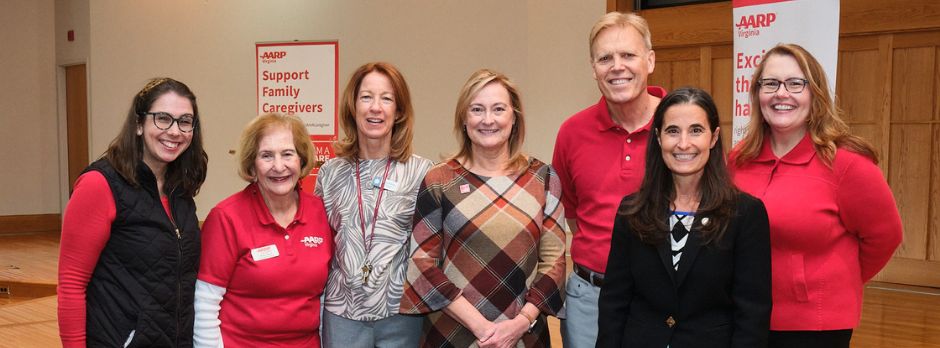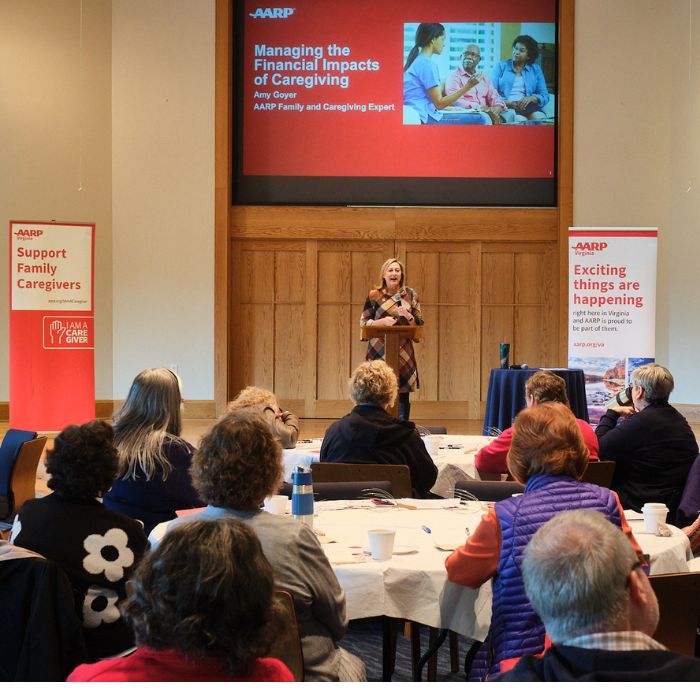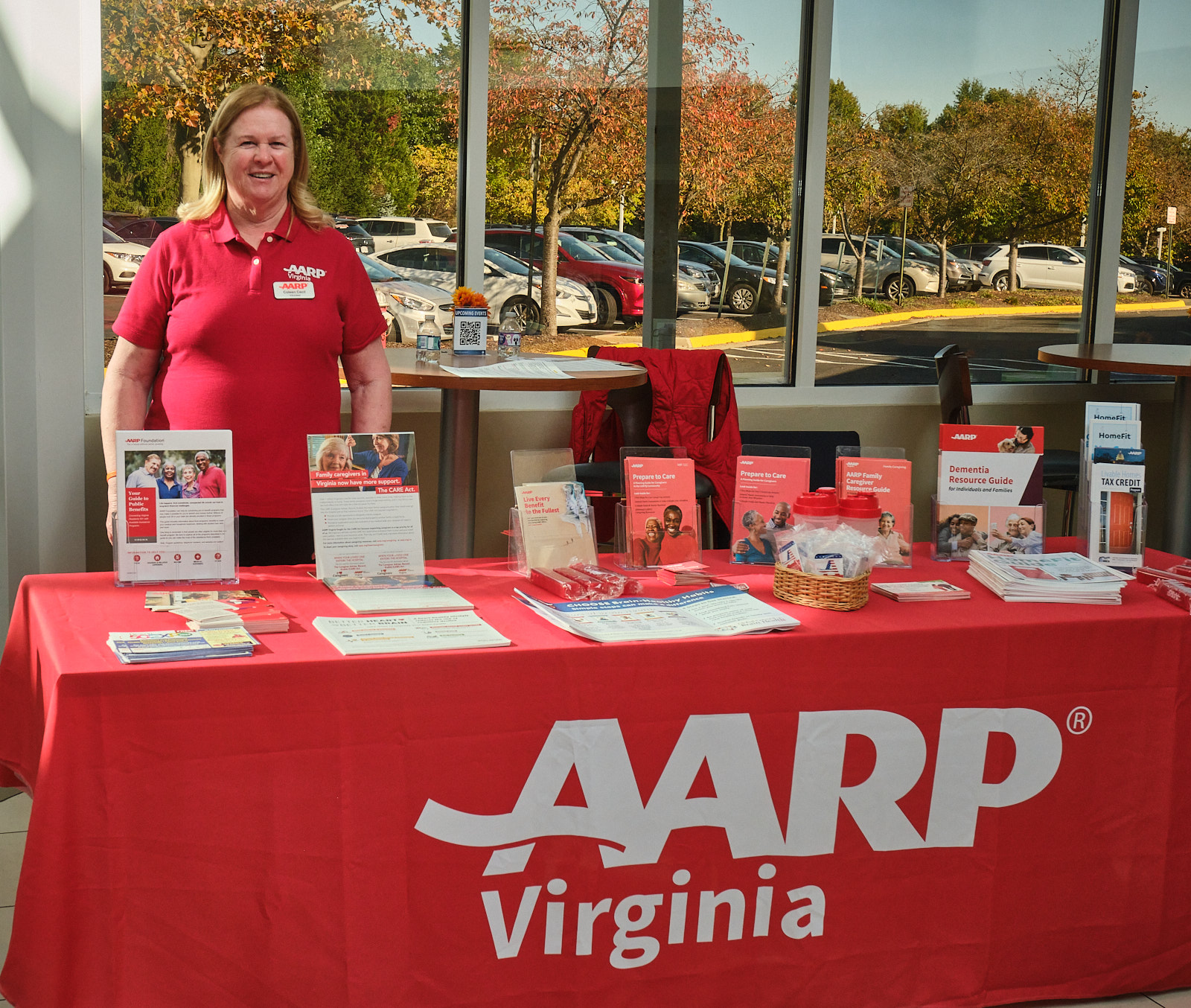Empowering You for the Life Ahead

With a focus on planning for the financial aspects of caregiving, a recent AARP Virginia Empowering You for the Life Ahead conference provided attendees with valuable information to help navigate the caregiving journey.
“I’ve been a caregiver almost all of my life,” said Amy Goyer, the keynote speaker. The caregiving journey for Goyer, AARP’s national family and caregiving expert, began in college with her grandparents. Her parents had moved to Arizona, and Goyer travelled back and forth from Ohio to Indiana to care for both sets of grandparents until their deaths.
In Arizona, her mother had a stroke at age 63. While her father was active in retirement and busy caring for her mother, Goyer noticed small changes in his behavior that resulted in a diagnosis of Alzheimer's disease.
Goyer, who by then was working for AARP in Washington, D.C., quit her job to work as a consultant, enabling her to spend half of her time in Arizona with her parents and half at her home in Alexandria, Va.
As her parents continued to have health issues and eventually died, Goyer suffered other family crises. A niece, who had been diagnosed with bipolar disorder, committed suicide. One of her sisters was diagnosed with Cushing’s disease and ultimately died, leaving two daughters that Goyer helped financially.
“Life after caregiving was not what I thought it would be,” said Goyer. Her health and personal relationships suffered, but the “financial devastation was the worst.”
In trying to take care of others, Goyer did not take care of herself financially. Although both of her parents had Social Security benefits and long-term care insurance and her father had a pension and benefits through the Department of Veterans Affairs, Goyer ended up paying for many of their expenses out of pocket, depleting her retirement savings in the process.
According to AARP’s 2021 Cost of Caregiving Survey, 78% of caregivers incur out of pocket caregiving costs. The average cost was $7,242 per year, which increased to $8,978 per year if caring for someone with dementia. Costs are higher if caring long distance or having other factors such as mental health or work stress issues. African American and Hispanic caregivers tend to have higher costs.
Household expenses, such as payments for rent or mortgage and home modifications, make up over 50% of caregiver costs. Other costs include medical needs, personal care, recreation, legal issues, and caregiver personal expenses such as travel.
Like Goyer, most caregivers dip into personal or retirement savings or take loans to help meet expenses. The survey found that six in 10 caregivers were overwhelmed by financial stress.

As home care costs increase, Goyer urges caregivers to work with a financial advisor at the beginning of the process to assure the caregiver’s own financial needs remain healthy.
A financial advisor will review assets for both the caregiver and the person in care, looking at income such as pension and retirement savings, Social Security, and investments, balancing them with necessary expenses, such a housing, health care, meals, transportation, and other expenses.
While traditional Medicare pays for short-term in-home care and palliative and hospice care, long-term care plans can help cover costs that aren’t covered by Medicare, Medicaid, or other insurance plans. A financial advisor can help caregivers find the best plans for them and their care partners. The VA has numerous benefits for eligible individuals, including caregivers, through their caregiver support line. AARP also offers support for veterans and military families.
Many communities have services that provide benefits to seniors, including caregiver support. The non-profit Virginia Navigator can help caregivers in Virginia find services near them. AARP’s family caregiving website helps caregivers find resources, education, and support, including financial and legal assistance.
“Part of taking care of someone is taking care of one’s own finances,” said Goyer.
Nancy Fagan, chief operating officer of Continuum Care Strategies, led a workshop in understanding care options and associated costs, getting into some of the specifics of different care options.
The first step, said Fagan, is to assess the person’s situation, looking at activities of daily living such as eating, bathing, dressing, walking, toileting, and grooming, as well as how well the person handles other functions like meal preparation, shopping, laundry, money management, and transportation.
“Money management,” said Fagan, “is often the most glaring problem” but is seldom talked about.
Next, look at physical and cognitive functions, including chronic conditions that may run in the family such as diabetes and psychiatric history, as well as memory concerns and executive functions.
After gathering a care team, consisting of family, extended family, an attorney, and a financial planner, look at different care options.
In addition to living at home with support, options include assisted living, memory care, long term nursing care, or a continuing care retirement community, which provides the last three options on one campus.
Fagan cautions against making promises to a loved one that they’ll never go to a care facility. “Any promises made are only as strong as reality,” said Fagan, with finances being the priority.
Some of the costs of staying at home include modifications, ongoing home expenses, caregiver stress, and cognition issues. Medicare only covers skilled home care, not family care, although some long-term care insurance plans may reimburse family caregivers.

In Northern Virginia, hiring an agency for in-home care costs $38 to $40 an hour for more than six hours a day, or $42 to $45 per hour if less than six hours. Privately engaged caregivers cost less, about $30 to $35 per hour, but Fagan cautions agencies generally have more control over who they send.
Assisted living and memory care facilities vary by need, population, and engagement, with many options available. Costs can range from $5,000 to $14,000 per month. The key, said Fagan, is finding the right fit. “Be an educated consumer – it’s not the cost but what you get for it.”
Long term, or nursing home care, usually is triggered by a rehab stay following an event such as a stroke, where there is no safe discharge to home and where medical needs exceed home-based or assisted living environments. Costs can run $14,000 to $17,000, although Medicaid will pay if the individual is eligible.
Continuing care communities include independent living, assisted living, and skilled nursing on the same campus, enabling individuals to move to different levels as needs change. Costs vary by facility, type of unit, and contract, and can be $300,000to $700,000 for an entry fee and $4,000 to $8,000 monthly.
Fagan recommends discussing finances and preferences ahead of time with family and blended family members. She also recommends considering placing assets in an irrevocable trust so money can be spent on oneself, not one’s heirs. Most importantly, she advises talking to a financial planner and a lawyer to work out the best plan of action.
Lauren Breeden, senior fellow at WISER (Women’s Institute for a Secure Retirement), focused on retirement security for caregivers. Echoing Goyer’s experience, Breeden said that some of the financial mistakes caregivers make include not making their own finances, including paying for their own care, a priority.
Caregivers often find their financial caregiving needs escalate over time. In addition, 28 states have “filial responsibly” laws that obligate adult children to care for their parents, although they are seldom strictly enforced.
Emergency savings accounts, in which one sets aside funds for three to six months of living expenses, can help caregivers with financial obligations while avoiding excessive credit card debt.
Breeden recommends caregivers keep important legal documents up to date for themselves as well as the person they are caring for. These include durable power of attorney; healthcare power of attorney and healthcare proxy; living trust, where you control assets during your lifetime but are transferred to a trustee after death; last will and testament; living will, or a declaration of your healthcare wishes when you are unable to communicate; and a care agreement for family and caregivers.
Care agreements are formal agreements that make the care and payment responsibilities clear for the caregiver, recipient, and other family members. These agreements can help avoid family conflicts about who will provide care and how much they will be paid.
These agreements should include when the care will begin, what specific care the caregiver will provide, how often and how long the care will last, payment amount and times of payment to the caregiver, how long the agreement is in effect, and a statement that allows changes only through agreement of both the caregiver and the recipient.
Like Goyer and Fagan, Breeden recommends caregivers enlist help from a financial planner to help them plan for their caregiving journey.
Steve Gurney, founder of Positive Aging, led a lively discussion about solo aging and the need to turn the tables on the concept of ageism.
“Unlike sexism and racism, ageism is not always intentional,” said Gurney. “Aging is used wrong. It really begins at birth,” not at the half-century mark.
Gurney cited a recent AARP study, which found that a substantial portion of 50-plus adults are solo agers, regardless of how they are defined. Solo agers include adults living alone, including those divorced or widowed; or married adults or those in a long-term partnership; who either have no living children, at least one living child but are estranged from them, or who have at least one living child but do not think their children could care for them.
The survey found solo agers are more concerned about various aspects of aging than other 50-plus adults, including losing independence and relying on others; not having enough money; being alone without family and friends; not being able to stay in their current home; being moved somewhere against their will; and needing help with daily activities.
Gurney’s organization runs regular solo aging podcasts, and one of the hot topics is meeting new friends and dating, as these activities become harder as people get older.
Another important topic is choosing the right trustee. “It takes creativity to determine who will best take care of you,” said Gurney. He recommends taking time to find the right person.
Empowerment and not being prepared is another key concern. This includes planning for mobility or cognitive issues, planning for what life would be like without the ability to drive or if one develops dementia or Alzheimer’s disease.
Many solo agers worry about whether to age in place or move. “No one wants to move to a senior living community,” said Gurney, but for some, these facilities help build a sense of community and foster friendships.
That said, Gurney says senior living facilities are the “last legally segregated facilities” since there are no young people. A sense of neighborhood is important, and sometimes a solo ager living in a multigenerational community may gain greater benefits.
Gurney stressed that, wherever one lives, building a personal village is key. “In regular life, we accumulate friends and family but often they don’t have assigned roles,” he said.
He recommends making a list of everyone in one’s life, imagining how helpful they may be, and assigning each a role. Of course, talking to them is important. Gurney recommends, rather than asking if they’ll take care of you, saying “I will take care of you if anything happens,” hopefully initiating a reciprocative conversation.
“We all think we are alone, but instead we’re all together” going through the same things, said Gurney.
Gurney’s organization, Positive Aging, produces a sourcebook of resources in the D.C. metro area, including housing, aging in place, and help for families. The sourcebook, along with links to podcasts, is available for free on the Positive Aging website.


